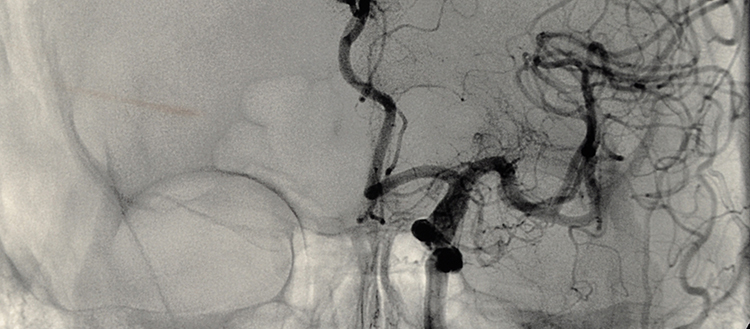Cell mutations give rise to brain aneurisms
Using innovating DNA analysis techniques, researchers at UNIGE and at the University of Toronto identified the underlying cause of brain arteriovenous malformations, and provide insight into potential therapies.

© all rights reserved
Sporadic arteriovenous malformations in the brain – a severe type of brain aneurisms – is a leading cause of haemorrhagic stroke in young adults and children. Affecting about 15 in 100 000 people, it consists of an abnormal development of the brain vascular system, potentially occurring during foetal life. By identifying its origin – a somatic mutation in endothelial cells that form the inner layer of blood vessels – researchers at the University of Geneva (UNIGE), Switzerland, and at the University of Toronto, Canada, show the impact of a somatic mutation and open some avenues to improved treatment. Their results can be read in the New England Journal of Medicine.
Brain arteriovenous malformations (BAVM) are a collection of anomalous vessels of the brain that are thought to develop during foetal life or early childhood. They consist of morphologically abnormal and direct connections between arteries and veins, where capillaries (the smallest type of blood vessels) are missing. When the pressure increases too much, BAVMs can rupture, causing a massive and potentially lethal brain haemorrhage.
“BAVM is primarily of sporadic nature, meaning that there is not a predisposition in families. This however does not mean that there is no genetic basis to it”, explains Sergey Nikolaev, a researcher in Bioinformatics at UNIGE Faculty of Medicine, biologist at the genomics consultation of the Geneva University Hospitals (HUG) and the article’s first author. “We therefore hypothesized that it may be associated with a DNA de novo mutation in brain cells, a mutation which is not present in the germinal cells, thus not inherited.” Another disorder that causes similar lesions, the Capillary malformation-arteriovenous malformation syndrome (CM-AVM), is due to an inherited mutation of the regulator of the KRAS gene (a gene essential to cell signalling in many tissues). Drawing a parallel, the scientists decided to look for brain malformations of BAVM patients that would have the mutation in the same pathway.
A complex DNA analysis methodology
They collected 26 samples from BAVM patients in Toronto, on which they performed DNA exome sequencing, looking for somatic mutations. “KRAS is a gene coding for a protein that performs. We found in some patients a KRAS mutation usually associated with certain types of cancer, such as melanoma. It gave us a first hint of where to look”, recounts Jason Fish of the University of Toronto, study co-author. The scientists used a new technology, called “droplet digital PCR”, which allows for a more precise analysis of DNA molecules. Thanks to it, they were able to identify mutations affecting only a very small proportion of cells present in the brain, the endothelial cells that form the inner layer of blood vessels. Out of their 72 samples from Toronto, Canada and Kuopio, Finland, 45 (62%) turned out positive for KRAS mutation.
Would treatment be possible?
KRAS activates pathways in the endothelial cells which can drive vascular growth. When mutated, it dysregulates angiogenesis and vascular remodelling. When these pathways are activated, the diameter of the vessel increases; consequently, arteries are misconnected with veins, causing an aneurism that can rupture at any time. “Our results show a very likely cause of brain arteriovenous malformations,” points out study last author Ivan Radovanovic, professor of neurosurgery at the University of Toronto, Canada.
“To understand what causes these malformations is a significant advance and it opens some avenues and hope for maybe improving their treatment, adding some options.” Among them, KRAS inhibitors could be tested for their ability to reduce the size of aneurism.
“Our study also suggests a context-dependent role for somatic KRAS mutations: arteriovenous malformations of the brain are not associated with cancer, and neither is endometriosis, where somatic activating KRAS mutations were also found in a previous study”, concludes Sergey Nikolaev.
